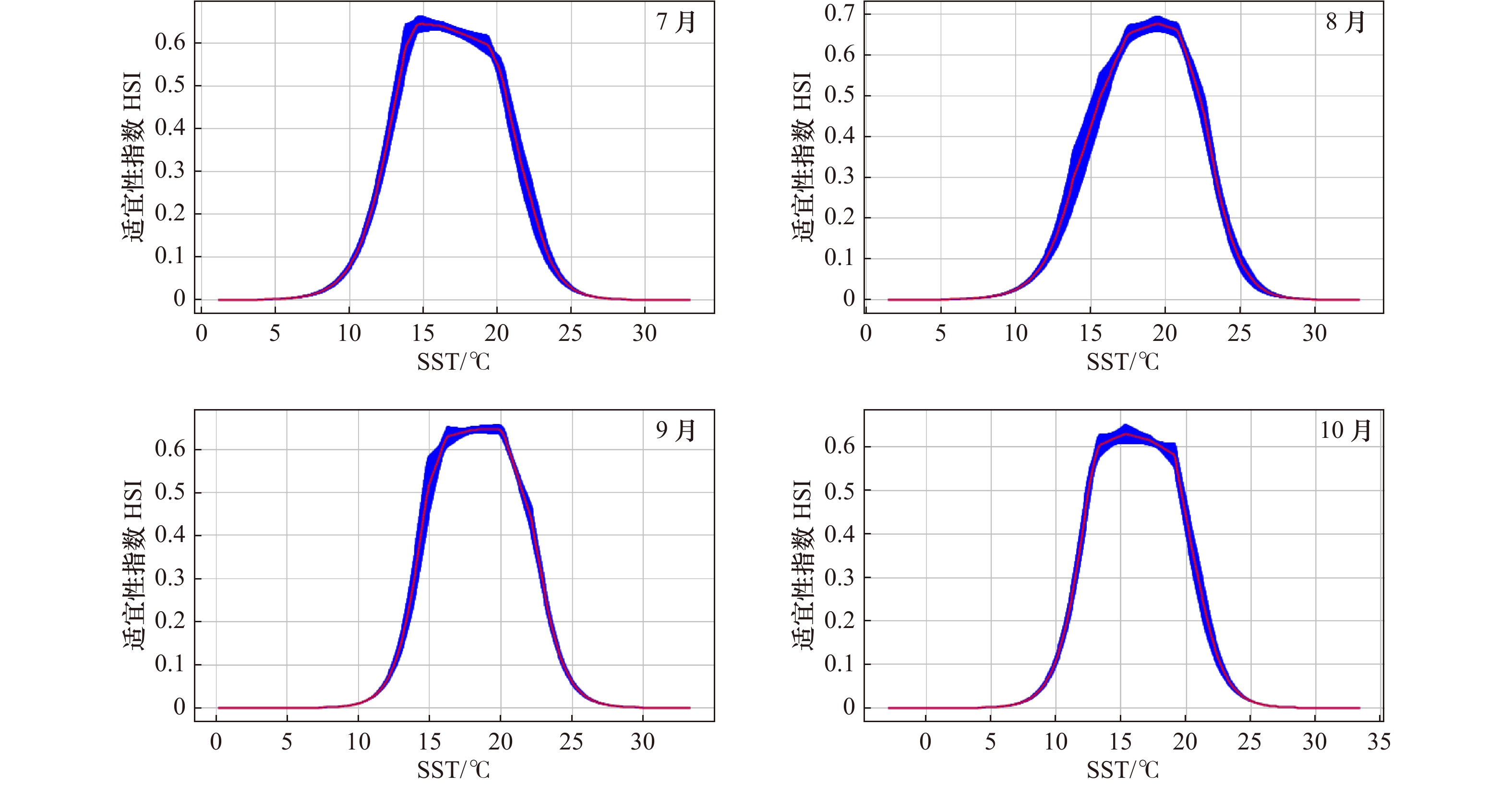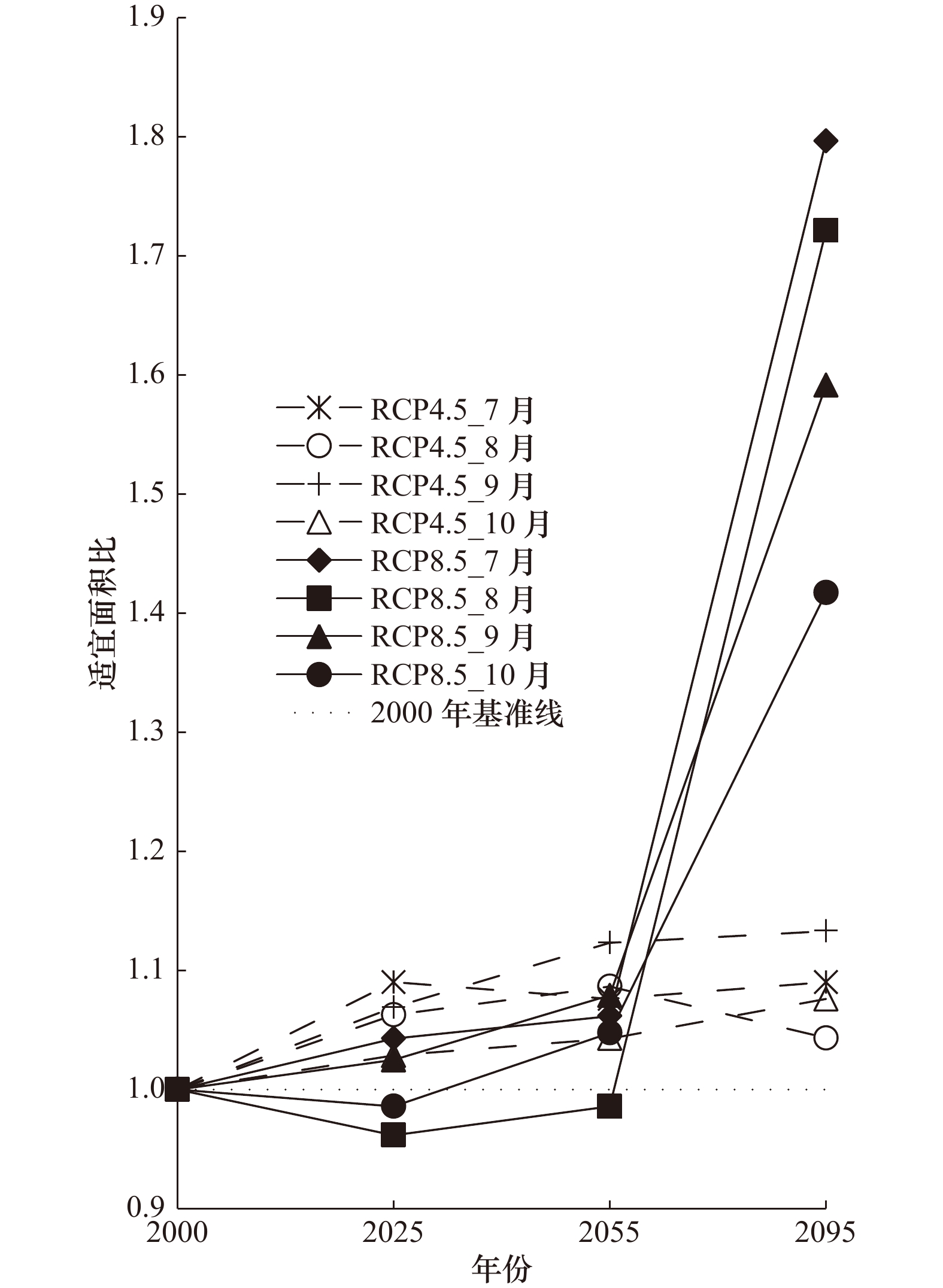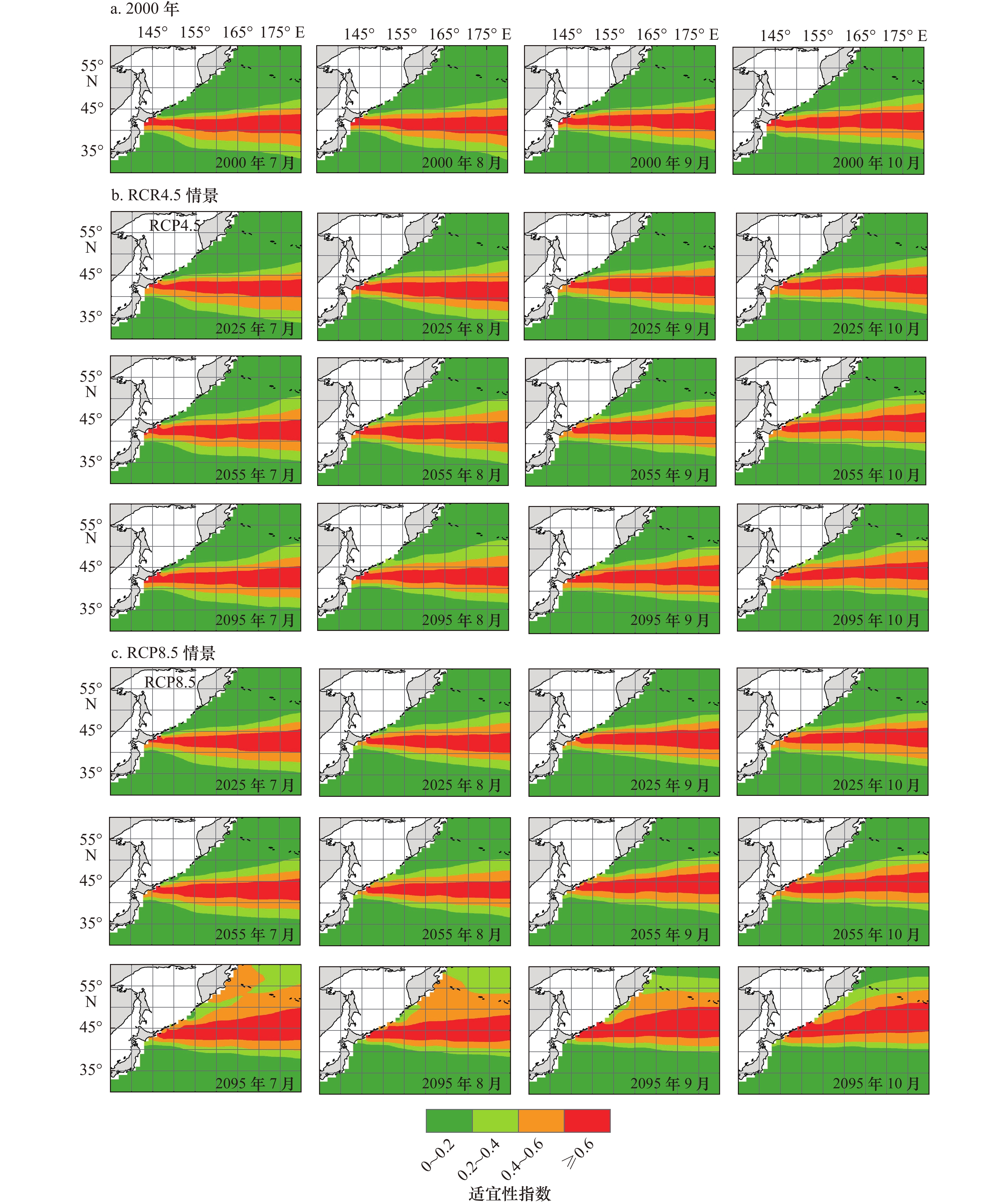Impacts of ocean warming on potential habitat distribution of Ommastrephes bartramii in the Northwest Pacific Ocean
-
摘要: 根据影响西北太平洋柔鱼栖息地分布的主导环境因子—海表面温度,基于最大熵模型,利用1996−2005年气候历史数据和两种不同情景(RCP4.5和RCP8.5)下的气候预估数据,分析了1996−2005年、2021−2030年、2051−2060年、2090−2100年主要捕捞月份(7−10月)柔鱼潜在栖息地变化。结果表明,柔鱼渔场纬度方向空间分布呈季节性南北移动;随着未来气候变化,在RCP4.5和RCP8.5两种情景下,2021−2030年、2051−2060年、2090−2100年7−10月柔鱼潜在栖息地分布较1996−2005年7−10月均呈现向北极移动趋势,适宜面积增加。推测柔鱼渔场季节性南北移动可能受各月适宜海表面温度范围变化的影响,在RCP4.5情景下,到21世纪末,各月柔鱼潜在最适宜生境向北移动1°~2°,适宜面积增加3%~13%;在RCP8.5情景下,到21世纪末,各月柔鱼潜在最适宜生境向北移动3°~5°,适宜面积增加42%~80%。Abstract: Based on the sea surface temperature (SST), which is the most dominant environmental climate factor affecting the distribution of squid, the potential habitat changes of Ommastrephes bartramii in July to October in 1996−2005, 2021−2030, 2051−2060 and 2090−2100 are analyzed using maximum entropy (MaxEnt) model with the historical climate data from 1996 to 2005 and the projection climate data from RCP4.5 and RCP8.5 scenarios. The results show that the fishing grounds of O. bartramii performs a seasonal north-south migration. Meanwhile, as the seasonal north-south migration of
O. bartramii may be affected by the suitable SST range in fishing season, with the feature climate change the potential habitat distribution of O. bartramii from July to September in 2021−2030, 2051−2060 and 2090−2100 will move northward and the suitable habitat area will increase compare to 1996−2005 under both scenarios of RCP4.5 and RCP8.0. Under scenario of RCP4.5, the potential most suitable habitat for O. bartramii will move northward by 1°−2° and the suitable habitat area will increase by 3%−13% by the end of the 21st century. Under scenario of RCP 8.5, the potential most suitable habitat for O. bartramii will move northward by 3°−5° and the suitable habitat area will increase by 42%−80% by the end of the 21st century. -
图 3 1996−2005年7−10月柔鱼潜在栖息地适宜性指数对海表面温度(SST)的响应曲线
红色为MaxEnt模型10次运算平均值;蓝色为标准差
Fig. 3 Monthly response of potential habitat suitability index for Ommastrephes bartramii to sea surface temperature (SST) from July to October of 1996−2005
Red represent mean of the 10 replicate MaxEnt model runs; blue represent the standard deviation
表 1 1996−2005年7−10月柔鱼潜在栖息地分布的MaxEnt模型统计测试结果
Tab. 1 Summary statistics derived from MaxEnt models for squid’s potential habitat from July to October of 1996−2005
月份 样本总数(N) AUC值 标准差(SD) 7月 124 0.938 0.006 8月 97 0.943 0.008 9月 88 0.950 0.006 10月 87 0.949 0.006 -
[1] Tylianakis J M, Didham R K, Bascompte J, et al. Global change and species interactions in terrestrial ecosystems[J]. Ecology Letters, 2008, 11(12): 1351−1363. doi: 10.1111/j.1461-0248.2008.01250.x [2] Cheung W W L, Lam V W Y, Sarmiento J L, et al. Projecting global marine biodiversity impacts under climate change scenarios[J]. Fish and Fisheries, 2009, 10(3): 235−251. doi: 10.1111/j.1467-2979.2008.00315.x [3] Cheung W W L, Lam V W Y, Sarmiento J L, et al. Large-scale redistribution of maximum fisheries catch potential in the global ocean under climate change[J]. Global Change Biology, 2010, 16(1): 24−35. doi: 10.1111/j.1365-2486.2009.01995.x [4] Freeman L A, Kleypas J A, Miller A J. Coral reef habitat response to climate change scenarios[J]. PLoS ONE, 2013, 8(12): e82404. doi: 10.1371/journal.pone.0082404 [5] Cheung W W L, Watson R, Pauly D. Signature of ocean warming in global fisheries catch[J]. Nature, 2013, 497(7449): 365−368. doi: 10.1038/nature12156 [6] Jones M C, Cheung W W L. Multi-model ensemble projections of climate change effects on global marine biodiversity[J]. ICES Journal of Marine Science, 2015, 72(3): 741−752. doi: 10.1093/icesjms/fsu172 [7] 王尧耕, 陈新军. 世界大洋性经济柔鱼类资源及其渔业[M]. 北京: 海洋出版社, 2005.Wang Yaogeng, Chen Xinjun. The Resource and Biology of Economic Oceanic Squid in the World[M]. Beijing: China Ocean Press, 2005. [8] Ichii T, Mahapatra K, Sakai M, et al. Changes in abundance of the neon flying squid Ommastrephes bartramii in relation to climate change in the central North Pacific Ocean[J]. Marine Ecology Progress Series, 2011, 441: 151−164. doi: 10.3354/meps09365 [9] Yu Wei, Chen Xinjun, Yi Qian, et al. Influence of oceanic climate variability on stock level of western winter-spring cohort of Ommastrephes bartramii in the Northwest Pacific Ocean[J]. International Journal of Remote Sensing, 2016, 37(17): 3974−3994. doi: 10.1080/01431161.2016.1204477 [10] Alabia I D, Saitoh S I, Mugo R, et al. Seasonal potential fishing ground prediction of neon flying squid (Ommastrephes bartramii) in the western and central North Pacific[J]. Fisheries Oceanography, 2015, 24(2): 190−203. doi: 10.1111/fog.12102 [11] Gong Caixia, Chen Xinjun, Gao Feng, et al. Importance of weighting for multi-variable habitat suitability index model: a case study of winter-spring cohort of Ommastrephes bartramii in the northwestern Pacific Ocean[J]. Journal of Ocean University of China, 2012, 11(2): 241−248. doi: 10.1007/s11802-012-1898-6 [12] 陈新军, 刘必林, 田思泉, 等. 利用基于表温因子的栖息地模型预测西北太平洋柔鱼(Ommastrephes bartramii)渔场[J]. 海洋与湖沼, 2009, 40(6): 707−713. doi: 10.3321/j.issn:0029-814X.2009.06.006Chen Xinjun, Liu Bilin, Tian Siquan, et al. Forecasting the fishing ground of Ommastrephes bartramii with SST-based habitat suitability modelling in northwestern Pacific[J]. Oceanologia et Limnologia Sinica, 2009, 40(6): 707−713. doi: 10.3321/j.issn:0029-814X.2009.06.006 [13] Cao Jie, Chen Xinjun, Chen Yong. Influence of surface oceanographic variability on abundance of the western winter-spring cohort of neon flying squid Ommastrephes bartramii in the Nw Pacific Ocean[J]. Marine Ecology Progress Series, 2009, 381(12): 119−127. [14] 赵宗慈, 罗勇, 黄建斌. 从检验CMIP5气候模式看CMIP6地球系统模式的发展[J]. 气候变化研究进展, 2018, 14(6): 643−648.Zhao Zongci, Luo Yong, Huang Jianbin. The detection of the CMIP5 climate model to see the development of CMIP6 earth system models[J]. Climate Change Research, 2018, 14(6): 643−648. [15] IPCC. 气候变化2014: 综合报告[R]. 日内瓦: IPCC, 2014: 1-151.IPCC. Climate change 2014: synthesis report[R]. Geneva: IPCC, 2014: 1−151. [16] Gent P R, Danabasoglu G, Donner L J, et al. The community climate system model version 4[J]. Journal of Climate, 2011, 24(19): 4973−4991. doi: 10.1175/2011JCLI4083.1 [17] Long M C, Lindsay K, Peacock S, et al. Twentieth-century oceanic carbon uptake and storage in CESM1(BGC)[J]. Journal of Climate, 2013, 26(18): 6775−6800. doi: 10.1175/JCLI-D-12-00184.1 [18] Phillips S J, Anderson R P, Schapire R E. Maximum entropy modeling of species geographic distributions[J]. Ecological Modelling, 2006, 190(3/4): 231−259. [19] 陈芃, 陈新军. 基于最大熵模型分析西南大西洋阿根廷滑柔鱼栖息地分布[J]. 水产学报, 2016, 40(6): 893−902.Chen Peng, Chen Xinjun. Analysis of habitat distribution of Argentine shortfin squid (Illex argentinus) in the Southwest Atlantic Ocean using maximum entropy model[J]. Journal of Fisheries of China, 2016, 40(6): 893−902. [20] Phillips S J. A brief tutorial on Maxent[EB/OL]. [2019−03−07]. http://biodiversityinformatics.amnh.org/open_source/maxent/. [21] Ichii T, Mahapatra K, Sakai M, et al. Life history of the neon flying squid: effect of the oceanographic regime in the North Pacific Ocean[J]. Marine Ecology Progress Series, 2009, 378: 1−11. doi: 10.3354/meps07873 [22] 陈新军, 田思泉. 西北太平洋海域柔鱼的产量分布及作业渔场与表温的关系研究[J]. 中国海洋大学学报 (自然科学版), 2005, 35(1): 101−107.Chen Xinjun, Tian Siquan. Study on the catch distribution and relationship between fishing ground and surface temperature for Ommastrephes bartrami in the northwestern Pacific Ocean[J]. Periodical of Ocean University of China, 2005, 35(1): 101−107. [23] 余为. 西北太平洋柔鱼冬春生群对气候与环境变化的响应机制研究[D]. 上海: 上海海洋大学, 2016.Yu Wei. Response mechanism of winter-spring cohort of neon flying squid to the climatic and environmental variability in the Northwest Pacific Ocean[D]. Shanghai: Shanghai Ocean University, 2016 [24] 刘娜, 王辉, 张蕴斐. 基于IPCC预测结果的北太平洋海表面温度变化分析[J]. 海洋学报, 2014, 36(7): 9−16.Liu Na, Wang Hui, Zhang Yunfei. Variation of sea surface temperature in the North Pacific based on different IPCC scenarios[J]. Haiyang Xuebao, 2014, 36(7): 9−16. [25] 曹杰. 西北太平洋柔鱼资源评估与管理[D]. 上海: 上海海洋大学, 2010.Cao Jie. Stock assessment and risk analysis of management strategies for neon flying squid (Ommastrephes bartramii) in the Northwest Pacific Ocean[D]. Shanghai: Shanghai Ocean University, 2010. [26] 范江涛, 陈新军, 曹杰, 等. 西北太平洋柔鱼渔场变化与黑潮的关系[J]. 上海海洋大学学报, 2010, 19(3): 378−384.Fan Jiangtao, Chen Xinjun, Cao Jie, et al. The variation of fishing ground of Ommastrephes bartramii in the Northwest Pacific concerning with Kuroshio current[J]. Journal of Shanghai Ocean University, 2010, 19(3): 378−384. [27] FAO. Climate change implications for fisheries and aquaculture: summary of the findings of the intergovernmental panel on climate change fifth assessment report [R]. Rome: FAO, 2016. [28] Nguyen K D T, Morley S A, Lai C H, et al. Upper temperature limits of tropical marine ectotherms: global warming implications[J]. PLoS ONE, 2011, 6(12): e29340. [29] Alabia I D, Saitoh S I, Igarashi H, et al. Future projected impacts of ocean warming to potential squid habitat in western and central North Pacific[J]. ICES Journal of Marine Science, 2016, 73(5): 1343−1356. doi: 10.1093/icesjms/fsv203 [30] Shultz A D, Zuckerman Z C, Tewart H A, et al. Seasonal blood chemistry response of sub-tropical nearshore fishes to climate change[J]. Conservation Physiology, 2014, 2(1): cou028. doi: 10.1093/conphys/cou028 [31] Jones M C, Dye S R, Pinnegar J K, et al. Modelling commercial fish distributions: prediction and assessment using different approaches[J]. Ecological Modelling, 2012, 225: 133−145. doi: 10.1016/j.ecolmodel.2011.11.003 -





 下载:
下载:





